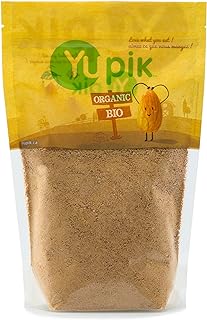5 important factors worth considering when looking for the best cacao powder
When choosing the right cacao powder for you, it’s important to consider a few key things. Understanding where the cacao comes from, such as if it’s organic or fair trade, is crucial. You should also know the difference between natural and dutch-processed cacao. These factors can affect the quality and ethical aspects of your purchase. It’s not just about taste – looking into how the cacao is processed, its nutritional value, and if sustainable practices are used can give you a deeper understanding of the cacao powder you use in your cooking.
See our guide to the best cacao powder.
Quality (organic, fair trade, raw)
When you buy cacao powder, it’s important to focus on quality. Choosing organic cacao powder means you’re avoiding harmful pesticides and supporting a natural way of doing things. Fair trade cacao powder goes beyond just eating it – it shows a commitment to helping communities and sustainable farming. When you choose fair trade, you’re joining a worldwide effort to promote fairness and ethical trade practices. Raw cacao powder has a natural appeal, keeping the bean’s nutrients intact. This pure form of cacao ensures that the bean’s essence is preserved, giving you a rich culinary experience that connects to ancient knowledge and purity. Each bite or sip is a journey from the earth to your plate, blending flavor and ethics in a delightful way.
Cocoa content (percentage of cacao in the powder)
When picking cacao powder, it’s important to look at the cocoa percentage on the package. This number affects the taste and health benefits you get from the powder. More cocoa means a stronger chocolate flavor, perfect for rich desserts or savory dishes. It also means more antioxidants and nutrients, like flavonoids, which are good for your heart and health.
Cacao powders with less cocoa are better if you want a milder taste or need an ingredient for many recipes. They still have good properties, just not as concentrated. The choice between high and low cocoa content powders depends on personal preference and how you plan to use it. Whether you love to bake or want to stay healthy, knowing the cocoa content of cacao powder will help you make the right choice for your cooking and health.
Processing method (dutch-processed, natural)
Selecting the right cacao powder involves considering how it’s created, which affects the taste and health benefits. Dutch-processed cacao powder is treated with alkali, resulting in a smoother, less acidic flavor great for baking and desserts. On the other hand, natural cacao powder keeps more of its original acidity and fruity notes, making it suitable for both sweet and savory dishes. While Dutch-processed cacao is easier for some to enjoy, purists often prefer the authentic taste of natural cacao.
Ultimately, choosing between Dutch-processed and natural cacao powder depends on your preferences and how you plan to use it. If you want cacao powder that works well in sweet recipes, go for Dutch-processed. But if you appreciate the rich, varied flavors of cacao beans, natural cacao powder is the way to go. Understanding how cacao powder is processed can enhance your cooking and give you a delicious chocolate experience.
Source (origin of the cacao beans)
When buying cacao powder, it’s important to consider where the cacao beans come from. Where the beans are grown affects the quality and taste of the final product. Choosing cacao powder made from sustainably sourced beans ensures great taste and supports ethical farming practices.
Different regions produce cacao beans with unique flavors and aromas. Beans from South America have fruity undertones, while those from Africa have earthy notes. By choosing cacao powder from specific regions known for their exceptional beans, consumers can enhance their culinary experiences and appreciate the different flavors each origin offers.
Exploring the world of cacao sourcing reveals a variety of flavors that reflect the distinct characteristics of each region. Selecting cacao powder from reputable regions not only results in a better product but also helps preserve traditional farming methods and support cacao farmers worldwide.
Price
When buying cacao powder, the price is important. Some people think choosing the cheapest option is best, but this could mean lower quality. Cheap cacao powder might have other ingredients or be processed too much, making it less healthy and flavorful. On the other hand, spending a little more on high-quality cacao powder can improve your cooking with its rich taste and health benefits. The saying, “you get what you pay for,” is true for cacao powder. A higher price often means better sourcing, processing, and overall quality.
While money is a concern for many people, choosing quality over quantity when buying cacao powder can be more satisfying in the long run. By considering things like where the cacao comes from, how pure it is, and if it’s organic, instead of just focusing on price, you can get a better product that fits your values and tastes. Spending a bit more on high-quality cacao powder not only makes your recipes taste better and be healthier but also supports sustainable and ethical practices in the cacao industry, benefiting you and everyone involved.
Conclusion
In conclusion, cacao powder is a versatile and nutritious ingredient that can enhance the flavor of many dishes while also offering numerous health benefits. Its chocolatey taste and antioxidants make it a great addition to any kitchen. Cacao powder helps improve mood, reduce inflammation, support heart health, and provide energy, making it a nutrient powerhouse. Whether you enjoy it in hot chocolate, oatmeal, or baked goods, the benefits of cacao powder go beyond just taste, making it a valuable addition to your pantry. Want more info on smoke eliminator for car, check the best smoke eliminator for car.


